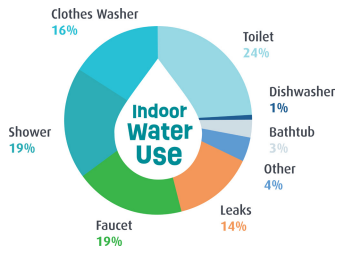Despite our rainy climate, the reservoir's capacity must last all year, especially during dry summers with little rain. By making waterwise choices, we can delay expensive infrastructure upgrades, ensure enough drinking water for a growing population, maintain a healthy ecosystem, and adapt to climate change.
Make every drop count!
Save water the easy way! Adopt a few waterwise habits, stay on top of leaks, understand how much water you use, and upgrade to high-efficiency fixtures. You’ll cut waste, lower your bills, and keep things flowing smoothly at home.
Waterwise habits
For an easy way to contribute to water conservation integrate the tips below into your daily routines and share them with your friends and family!
Fixing a leak
Household leaks account for 14% of all indoor water use. The most common issues are leaky toilets, faucets, irrigation systems, and showerheads. Simple and inexpensive repairs can prevent the wastage of drinking water. Regularly fix any leaking fixtures and check your toilet for hidden leaks at least once a year. An intermittent drip from your faucet or showerhead can waste more than 35,000 litres of water a year, costing you money. This wasted water could fill a bathtub over 100 times! If you have a dripping faucet, don't delay - fix it right away.
How much water do you really use?
Understanding how much water you use is the first step toward conservation, and calculating it is easier than you think!

This pie chart shows where water is used inside the home: The toilet uses almost one quarter of all the water, with showering, faucets, clothes washer, and leaks coming close behind.
Percentage of Water Used in Home | Appliance |
|---|---|
24% | Toilet |
19% | Shower |
19% | Faucet |
16% | Clothes Washer |
14% | Leaks |
4% | Other |
3% | Bathtub |
1% | Dishwasher |
From this chart we can see that about 19% of all the water used in a typical home comes from showering. Those extra minutes of lathering can really add up! Measuring your showerhead’s flow rate is a quick and eye-opening way to see how much water you use and to find simple ways to save.
Measure Your Showerhead’s Flow Rate
See Your Daily Water Use
To understand how to conserve water, it's helpful to understand how much water your household uses. Once you know your shower’s flow rate, it’s easy to calculate how much water you use per shower. Just multiply the flow rate (L/minute) by the amount of time you shower (minuntes)
Example: If your showerhead flows at 11 L/min and you shower for 10 minutes, you’ll use about 110 litres of water in just one shower!
Interested in estimating more of your water use? Check out this helpful water calculator to understand your water consumption in other areas of your home.
High efficiency fixtures and appliances
Switching to water-efficient appliances is one of the easiest ways to save water every day without changing your routine. These appliances use less water for daily tasks like washing dishes, doing laundry, and cleaning, helping you:
- Cut down your water use and ease the demand on local water supplies
- Save energy by using less hot water
- Lower your utility bills month after month
It’s a smart, eco-friendly choice that’s good for your home, your community, and your wallet.
Explore the fixtures and appliances below to see how you can make your home more water-wise.




